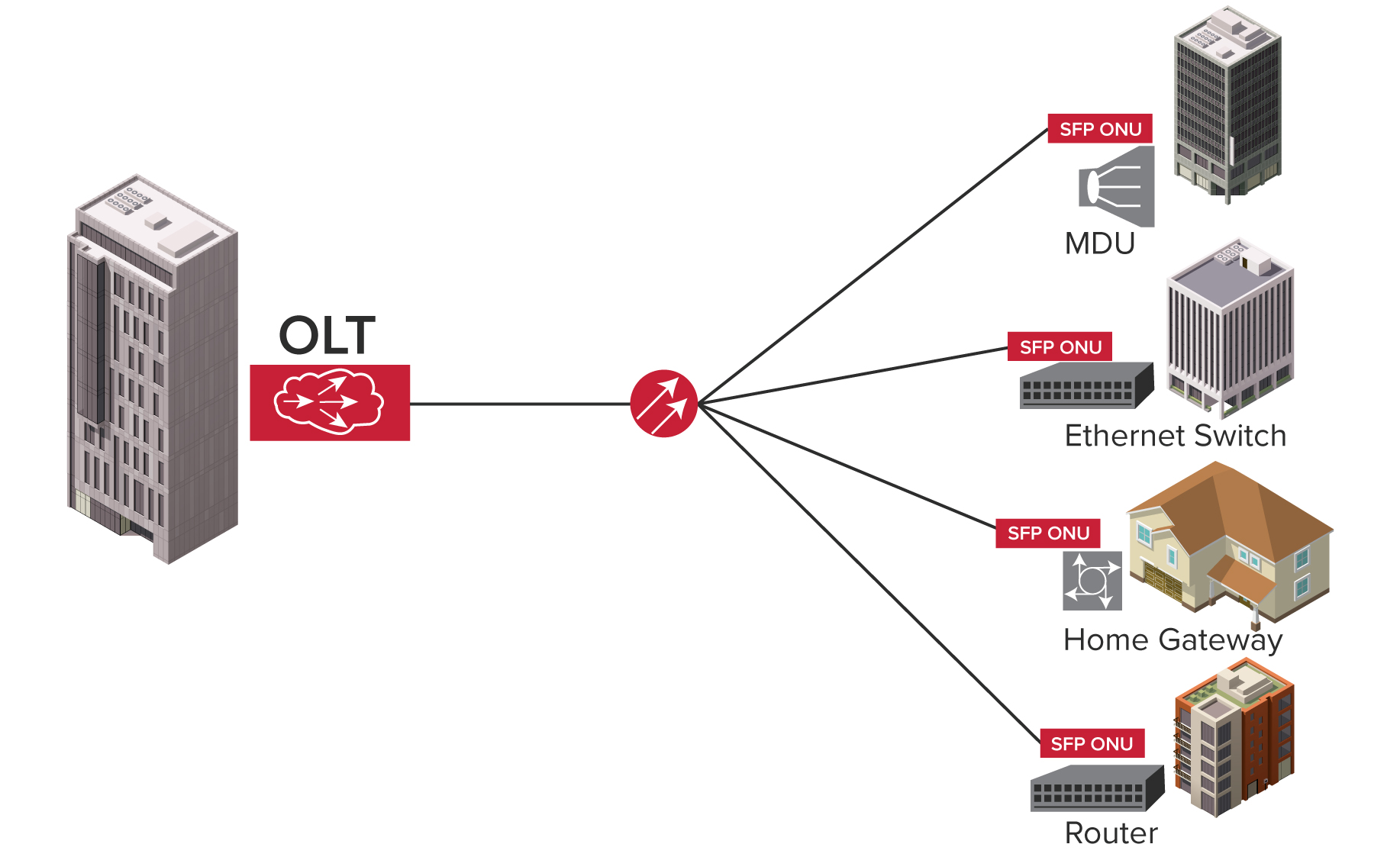
ONU/MAC-On-A-Stick: Portable 10G xPON Solutions

Passive Optical Networks (PON) utilize passive(unpowered) optical components to distribute data, voice, and video signals to multiple subscribers. Increasing capacity, high-speed connectivity and the need for flexibility continue to grow the adoption of Next-Gen PON technologies such as 10G EPON and XGS PON, which we’ll collectively call 10G xPON. Internet service providers are key players in driving the adoption of 10G xPON as it enables the delivery of bandwidth-intensive applications such as high-definition video streaming, cloud computing, online gaming and IoT connectivity.
In traditional PON architectures, a central office or exchange location houses the Optical Line Terminal (OLT) which acts as the control and aggregation point for the network. From the OLT, a single fiber is split into multiple fibers using a passive optical splitter. These fibers then connect to Optical Network Units (ONUs) or Optical Network Terminals (ONTs) located at the subscriber premises. Collectively, the part of the system extending from the OLTs to the ONUs is called the Optical Distribution Network (ODN), providing service to multiple locations and types of subscribers.
Transceiver Technology for 10G xPON Solutions
Note that the terms ONU and ONT are often used interchangeably. Functionally, they both serve the same purpose of providing connectivity between the optical network and end-user devices. Historically, the device would be called an ONT in an XGS PON network, and an ONU in an EPON network. For our purposes, we’ll refer to it as an ONU.
Advances in optics technology have made it possible to replace the ONU in an xPON with a single pluggable transceiver. The SFP10G-XSONU-N1I is one such example, as it can replace the ONU in an XGS-PON (10G Symmetrical Passive Optical Network). This powerful transceiver also has a MAC (Media Access Control) address, which is a unique identifier that plays a crucial role in facilitating communication and ensuring data is delivered to the intended destination on a local network. The SFP10G-XSONU-N1I and similar ONU/MAC-On-A-Stick products make it possible to offer broadband service to any customer. They turn any network equipment with an SFP+ port into a PON access device. This includes CPE(customer premises equipment) such as routers and switches. Shown in Figure 1 is an xPON network utilizing ONU/MAC-On-A-Stick transceivers (SFP ONUs) for various use cases.

Figure 1 xPON Network Utilizing SFP ONUs (ie ONU/MAC-On-A-Stick)
The XGSPON SFP10G-XSONU-N1I has the following features:
- XGSPON ONT/ONU with MAC, I-Temp Rated
- 1270/1577nm XGSPON Wavelenths & Digital Diagnostic Monitoring (DDM)
- CPE functionality in an SFP form factor
- <2.1 W Power Consumption & 10G Optical Symmetrical Data Rate
- 1G/10G UNI
- SC/APC or SC/UPC Connector
Figure 2 provides a closer look at an ONU/MAC-On-A-Stick as used in network equipment such as a switch.

Figure 2 Example use case: xPON ONU/Mac-On-A-Stick plugging into a switch
Applications for Portable 10G xPON Solutions
Soon ONU/MAC-On-A-Stick products may be used to model and manage nearly any CPE (Customer Premises Equipment). They can effectively turn any CPE (switch, router, etc..) with an SFP+ port into a PON access device. Where a PON system is already in place, the ONU/MAC-On-A-Stick can be used to monitor remote (outside plant) active equipment. This is currently one of the most common use cases. Without monitoring, it’s very difficult to tell exactly what is happening when a remote OLT or other piece of equipment fails. By utilizing the existing xPON network and SFP port on the active equipment, the ONU/MAC-On-A-Stick will allow access to monitor the diagnostic/status information remotely. In the case of any abnormal conditions or other telemetry data collected from the ONU/MAC-On-A-Stick, it can raise alarms or send notifications to the OLT. These alerts help the network operator or Network Operations Center (NOC) identify and respond to issues promptly.
Going one step further, this technology enables ISPs (Internet Service Providers) with an existing PON network in place to potentially broaden their service portfolio. By utilizing the ONU/MAC-On-A-Stick with its SFP form factor, they can easily connect to a switch or router and offer additional services like business connectivity alongside the residential services commonly provided by PON. Consequently, even platforms that traditionally lack xPON support can now directly provide xPON services to their business customers.
Compatibility Considerations for 10G xPON
To deploy the ONU/MAC-On-A-Stick, it is essential to collaborate with a supplier proficient in developing dual compatibilities:
1)compatibility with the host device
2)compatibility with the OLT device
While ONU/MAC-On-A-Stick products like the SFP10G-XSONU-N1I may look and operate similarly to standard SFP modules, they possess significantly more complex feature sets which require extensive engineering knowledge and support. Precision OT excels in the design and development of advanced 10G xPON parts capable of operating across many service provider environments with the potential for limitless compatibilities.
ONU/MAC-on-a-stick 10G xPON pluggable solutions offer an excellent option for remotely monitoring devices in xPON networks. They can also enable platforms which traditionally do not support PON to offer PON services directly to business customers. For more information about xPON solutions and all your optical networking needs, contact the experts at Precision OT!






